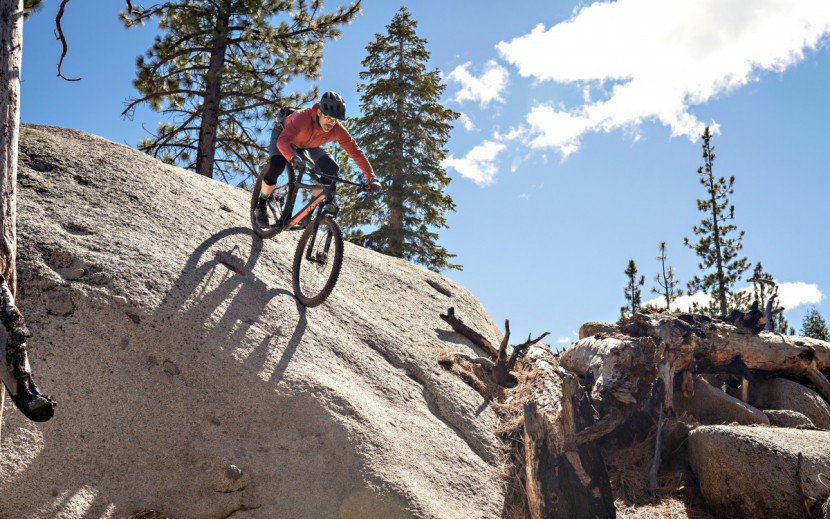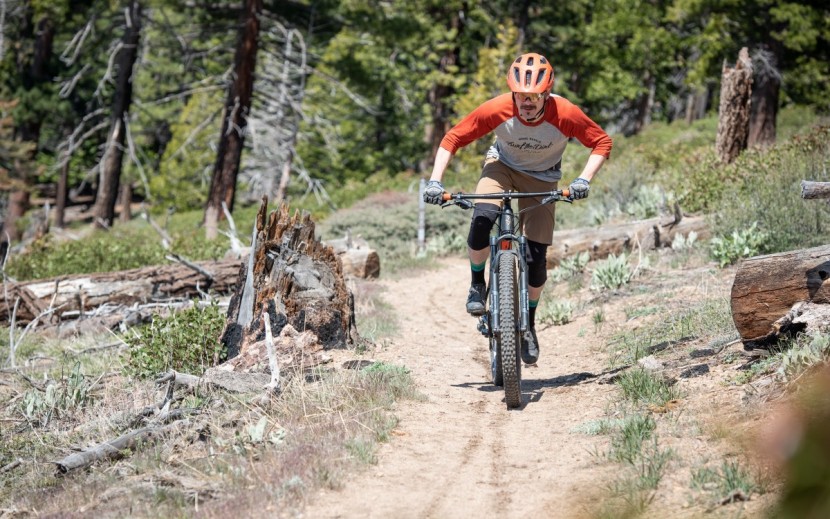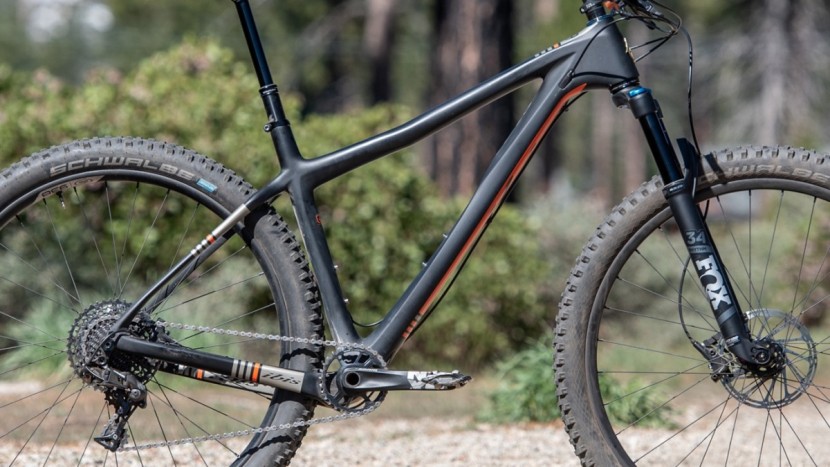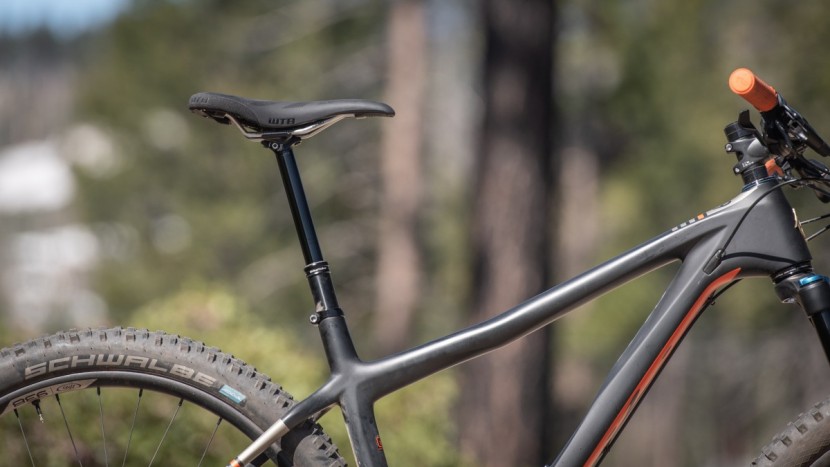Ibis DV9 NX Review

Our Verdict
Our Analysis and Test Results
Should I Buy This Bike?
If you are seeking a trail hardtail that leans more towards the cross-country application, you should buy this bike. The DV9 is capable of serving as a daily driver and crushing the occasional cross-country race with a different set of tires. Heck, some people are even turning this rig into a gravel bike. This bike delivers stellar climbing abilities and precise downhill performance. If you are looking to get aggressive or frequently ride rough, rockier trails, we recommend looking elsewhere. While this bike is a blast carving down flow trails, its stiff carbon frame can be pretty harsh over rocks and roots.
Are you looking for an aggressive hardtail? The Rocky Mountain Growler 50 is a hardtail with the attitude of an enduro bike. This bicycle follows the long and low trend and features a slack head tube angle and low bottom bracket. As a result, the Growler is exceptionally confident at speed and on steeper terrain. The Ibis is a far better option for substantial amounts of climbing and racking up big miles, while the Commencal is a much more confident descender. The Growler 50 is the top-of-the-line model with a price of just $1,899.
Like the idea of a mile-crushing hardtail. The Trek Stache 9.7 is another fast-rolling carbon fiber bike that rolls on 29+ wheels. The 29 x 3.0-inch tires give this bike a monster truck attitude. While these giant wheels are slow to accelerate, they roll extremely fast and are quite stable at blistering speeds. These wheels stay out of bomb holes, and it is difficult to disturb their momentum when they have a head of steam. As they say, big wheels keep on rollin'. The Stache has a very efficient feel and is well suited for big rides. Climbing is excellent, and descending is harsh but relatively solid. Sharp corners present a problem for these giant wheels as they can feel quite bulky at slow speeds. The Ibis is far more nimble, has crisper handling, and accelerates faster. The Stache is faster in a straight line though the two bikes perform similarly on rough terrain.
Frame Design
The DV9 has a carbon fiber frame. It runs 29-inch wheels with clearance for tires up to 2.6-inches wide. Our test bike came stock with 2.6-inch Schwalbe's, and we can verify that there is almost no wiggle room with this max tire size. The tire is very, very close to the seat tube. Ibis designed this bike with a threaded bottom bracket and boost rear wheel spacing.
We measured our large DV9 and found a 630mm effective top tube and a 428mm reach. The bike does not feel as cramped as that short reach number suggests. The chainstays are 439mm long, and the wheelbase measured 1160mm. The bottom bracket is 322mm off of the ground. The head tube angle measures 67.4 degrees while the effective seat tube angle is 72.2-degrees. Our large test bike hit the scales and came in at a feathery 26 lbs 8 oz set up tubeless without pedals.
Design Highlights
- Available in carbon fiber only
- Compatible with 100 or 120mm fork.
- 29-inch wheels only with clearance for 2.6-inch tires
- Available sizes S-XL
- Threaded bottom bracket
- Boost spacing
- 7-year frame warranty
Downhill Performance
The DV9 delivers predictable downhill performance highlighted by its quick steering and excellent traction. It is not a bike you can cut loose the descent, that said, it rides well for a carbon fiber hardtail with a 120mm fork. This bike is at its best when it is slicing its way down fast and flowy trails and using its quick handling to find smart and smooth lines. Soft knees and elbows go a long way in ensuring a relatively comfortable ride.
This bicycle provides a comfortable and confident descending position. The 428mm reach measurement is deceiving. The cockpit has ample amounts of room and allows the rider to move around the top tube without feeling too cramped. The 780mm bars provide a controlled feel and peering down at the frame the large and sturdy looking tubes are confidence-inspiring.
The DV9 offers solid and predictable downhill performance. The 67.4-degree head tube angle is on the conservative side for 2019. The head tube angle isn't particularly steep, but 2019 is a time where 65-66-degree head tube angles are common, it feels steep in the relative sense. While a steep front end can detract from confidence at blistering speeds or when aimed down a chute, it creates very direct steering. Twitch your arms or dip a shoulder and the Ibis reacts quickly. This is hugely beneficial when you're working through a rock garden on a carbon hardtail. It is easy to change directions and get this bike on a good line. If line selection is poor, it is possible to correct your mistake quickly where longer bikes like the Commencal Meta HT AM will not allow it due to its length and raked out front-end.
The 439mm chainstays are on the shorter side of the spectrum without slotting into the crazy short category. A short rear end has a profound effect on a bike. First, it helps create a very snappy and concise cornering feel. It also delivers a very playful, manual-friendly ride. The downside is that short chainstays bring the rear axle forward towards the bottom bracket can deliver an exceptionally harsh feel. While longer chainstays can absorb some of the forces of the trail, short chainstays translate every rock and root to the rider. This is especially true with a stiff, carbon fiber, frame like the DV9. This isn't a crippling issue by any means, but it is something to consider if you live near rougher, chunkier, trails.
The build kit on our DV9 NX worked well on the descent. Even though the NX build is the least expensive and features some wallet-friendly components, Ibis made sure some of the critical specifications were done right. The pairing of a 2.6-inch Schwalbe Hans Dampf front tire and 2.6-inch Schwalbe Nobby Nic rear is fantastic. Wider tires allow you to run a lower tire pressure which delivers superior traction and also serves as a bit of damping. This is especially important on a carbon hardtail. The Schwalbe rubber provides impressive traction as well. The Fox Float 34 worked just fine, and the GRIP damper is a completeset it and forget it fork. The Fox Transfer dropper seat post is excellent and reliable. The SRAM Level brakes leave something to be desired, but they work well enough.
Climbing Performance
The DV9 climbs like a mountain goat with a light feel and zippy acceleration. It is clear this bike was designed to put in serious miles, and it does just that. The Ibis provides a comfortable position despite a relatively slack seat tube angle. This bicycle offers concise and surgical handling making tight switchbacks and awkward rock gardens a breeze.
The DV9 has a relatively slack seat tube angle at 72.2-degrees with the stock 120mm fork. According to Ibis, the seat tube angle is steepened up by one degree if you choose to run a 100mm fork. When you are in the seated climbing position your hips are a little bit behind the bottom bracket. This doesn't necessarily translate to any noticeable inefficiency, but it is worth noting as seat tube angle is a hot topic in 2019. The cockpit isn't huge, but it provides enough room to shuffle weight around as needed. This is important on steeper, technical pitches.
The DV9's acceleration is excellent. When you get on the gas, this bicycle goes. At 26 lbs 8 oz, our large DV9 NX is pretty darn light. It has a very light feel that is quite inspiring to push harder up the climb. This bike makes excellent use of rider energy and reinforces our finding that this is the best cross-country oriented hardtail we have tested. The 29er+ Trek Stache 9.7 has a similar feel. The big difference is the standard 29-inch wheels on the DV9 have noticeably more get-up-and-go compared to the monster truck 29 x 3.0-inch tires and big rims of the Stache.
The Ibis' uphill handling is impressive. As we mentioned in the downhill performance section of this review, this bicycle has a somewhat conservative 67.4-degree head tube angle. One of the bike benefits of a steeper head tube is superior slow speed and climbing steering. The DV9 is a fantastic example of this. This bike works through awkward switchbacks with ease and is able to slice and dice through funky rock gardens swiftly. The 1160mm wheelbase never felt clumsy or sluggish, and the Ibis felt surgical.
The front wheel of the DV9 remains planted on steeper pitches. Shorter chainstays can often cause the bike to loop out when you hammer the pedals on a steep climb. The shorter rear end provides a little less stability under pedaling forces. This is a total non-issue on the DV9 and the front end remains well-connected to the dirt. The Salsa Timberjack that we tested was a far different story. It was challenging to keep the Salsa's front wheel under control on steep uphill turns.
Riders who are used to full suspension bikes will need to remember to get up out of the saddle when motoring up any sort of chunky climb. Even small rock gardens will translate much of the trail surface through the frame and to the rider. It is a much more pleasant experience to stand up through any trail imperfections. It may sound like more work, but it will save you energy in the long run.
The build kit on our DV9 NX worked well on the climb. The 11-speed SRAM NX provides plenty of gear range, and some testers feel it shifts more crisply than the 12-speed NX Eagle drivetrain. The Schwalbe Nobby Nic hooks up well over technical trail features and resisted the urge to wash out on steeper, sandier, trails.
Photo Tour
Value
At $2550, it is easy to call the DV9 NX a strong value. While it may not have the flashiest build kit, it is perfectly functional. Ibis did well to make certain that key components like the tires and fork were properly outfitted. It is rare to find a carbon fiber hardtail at this price point, let alone one that delivers such high-end performance.
Conclusion
Ibis nailed it with the all-new DV9. Here at OutdoorGearLab, we love versatility, and this bicycle is a perfectly capable daily driver that can also serve as a cross country race weapon. Climbing is feathery and efficient with crisp handling. Descending is a blast providing you avoid large doses of rocks and roots. On top of all that, this performance comes at a reasonable price tag for a beautiful carbon frame.
| Awards | Best Hardtail to Serve As A Trail //and// Cross Country Bike |
|---|---|
| Price | $3,499 List Check Backcountry (on sale!) |
Overall Score  |
|
| Star Rating | |
| Bottom Line | A swift-climbing hardtail that could serve as a daily driver or a cross-country race bike |
| Pros | Swift climbing, sharp handling, excellent value |
| Cons | Not as fun on rough trails, 11-speed drivetrain |
| Rating Categories | Ibis DV9 NX |
| Fun Factor (25%) | |
| Downhill (30%) | |
| Climbing (30%) | |
| Build (15%) | |
| Specifications | Ibis DV9 NX |
| Wheel Size | 29" |
| Weight (w/o pedals) | 26 lbs 8 oz |
| Frame Material | Carbon |
| Frame Size Tested | Large |
| Available Sizes | S, M, L, XL |
| Fork | Fox Float Rhythm 34 |
| Wheelset | Ibis Hubs, Ibis 938 Alloy rims |
| Front Tire | Schwalbe Hans Dampf 2.6" |
| Rear Tire | Schwalbe Nobby Nic 2.6" |
| Shifters | SRAM NX 11-speed |
| Rear Derailleur | SRAM NX 11-Speed |
| Crankset | SRAM NX 30T |
| Bottom Bracket | SRAM GXP XR |
| Cassette | SRAM PG 1130 11-42T |
| Saddle | WTB Silverado 142 |
| Seatpost | KS E30i Dropper |
| Handlebar | Ibis 780mm Alloy |
| Stem | Ibis |
| Brakes | SRAM Level |
| Grips | Lizard Skins Charger Evo |
| Warranty | Seven Years |





















